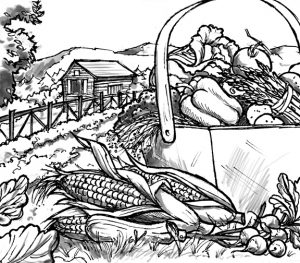Gardens Need Summer Heat
by Peter Heffelfinger
After a long winter of record rain, our Northwest gardens in July will be long overdue for heat and light to ripen our tomatoes and corn. An easily grown garden standby such as zucchini, however, will leap into high volume production mode, the small green tubes suddenly becoming heavy torpedoes. The trick, of course, is to pick often and early, searching under every leaf for each little zucchini, perfect for ratatouille or simple sautéing. This year, as an experiment, I seeded them early in my greenhouse, as a way of getting a head start on the harvest, but promising to use an eagle eye to make sure each little green fingerling is harvested immediately. Once a zucchini has been picked, remove a few large leaves on the main stem behind the stub, toward the root, to open up the plant to better spot other squash. And one can always fry up the flowers as a way of slowing down production.
Lettuces, best grown in cool weather, will quickly become bitter in the heat, with the tell-tale white sap extruding from the cut stem. Best to use shade cloth or plant in a shady spot, with lots of water since stress from aridity also increases the pace of bitterness. Pick leaf lettuces daily for salads, even if you don’t use it all, to keep the plants producing sweet leaves.
Tending the Worms
Since I have worm bins, I use the daily vegetable kitchen discards as a way of feeding the hungry red creatures in the dark, just like keeping farm animals well fed every day. The best part is that unlike goats baaing hungrily outside the garden fence, or chickens clucking anxiously around their yard, worms just munch on silently, never complaining, always ready to digest and produce lovely castings and compost. With the added heat of summer, it is wise to keep the bins moist and cool. Feed the worms and they will feed you when their manure is returned to the garden. The red composting worms, a special variety from warmer climes, do not survive in our relatively cool soil. Separate out the worms as best you can from the castings, and work the compost into prepared beds, directly underneath where you are about to plant. Home-grown organic manure is garden gold.
Leafy cilantro is famous for bolting immediately; best to sow or transplant every threeweeks for an adequate supply for the salsas that will be made from the oncoming tomatoes and peppers. The same applies to arugula, radishes, as well as to leafy Italian basil, which forms little seed buds at the end of every branch almost as soon as it leafs out. Bok Choy will also send up full blooms on fresh stalks that are ideal for a quick stir-fry for a meal. A quick treatment for these over-zealous plants is to graze daily in the garden, picking off the small buds that want to literally bolt up to the sun to make seed instead of becoming a mature, full-bodied plant first. I think of it as a walking-in-the-garden salad: a bit of arugula tip here, a bud of hot Asian mustard there, a few basil tips for green spiciness, and a chaser of overwintered parsley that is heading up. Every bud tastes more intense than the rest of the plant; it is an added level of zip, which is lost in the usual transition from garden to kitchen to table. It also helps if you are dedicated to the culinary pursuit of heat and spiciness. They say one’s taste buds gradually adjust to hot foods, eventually turning off the usual tongue-on-fire signal to the brain; best to keep those human buds in training, while one waits for the hot peppers to mature. The maritime Pacific Northwest may not be tropical yet, due to the changing climate, but we can grow some small items that will ignite your cuisine.
Broccoli 2
July is also the month to get a second round of broccoli in for a sustained harvest into fall. Broccoli is a crop one can grow just about year-round, from early spring plantings that should be heading up nicely now, to early summer transplants that will mature in August and September. In the spring and summer they need regular watering in order to develop the large central head, and a then second crop of smaller side-shoots. In late August transplant starts of purple sprouting broccoli; fall varieties will be harvested before the end of the year. Overwintering types will grow to a mature size before winter and then offer a welcome harvest of small buds in early spring.
Storing Garlic
Garlic comes to the end of its cycle in July: cloves planted last fall reach maturity soon after the spring rains have ceased. It is important to hold off watering for at least three weeks prior to harvest in order to prevent rot on the maturing bulbs. As the garlic beds dry out, I snip off all the scapes, the narrow seed stalks that spring up from the center, in order for the plants to devote energy into the below-ground bulbs. Scapes can be straight or curly-cued, depending on the variety of garlic. They can be chopped fresh for soups and stir-fries, grilled or steamed with salmon, or added to soup stock if you have a lot of them. The chopped stems also freeze well: blanch quickly, chill in cold water, drain, and then spread on trays to freeze individually before storing loosely in plastic bags. Given that last year’s garlic harvest is long gone, the scapes are a welcome harbinger to the fresh cloves on the horizon.
Note: if you do have a large amount of stored garlic going soft in late winter, put all the solid, non-musty cloves in a food processor along with enough olive oil to make a soft paste, and a bit of canning salt. Process till smooth; store in pint jars with an additional thin layer of oil on top. The garlic spread will keep in the fridge for a month or two until the next harvest is in. The mix will turn slightly sweet and lose its bite, but is handy to have on hand. Sauté with onions for any basic dish you are assembling, use as a quick spread for making garlic bread or bruschetta, or add to salad dressing or a soup. It is another bridge from one year’s garlic crop to the next.
Garlic Harvest (Hard Neck Variety)
Wait until at least five of the leaf tips begin to turn brown before lifting the plants. Gently clean off any dirt; do not cut the bulbs off the stem yet. One option is to clean the plants immediately, since the outer sheaths can be removed more easily when fresh. Start from the upper part of the plant, where the outer leaves encircle the stem and then extend down over the bulb. Strip off 1-2 sheaths at a time, making sure there are at least 2-3 layers of papery skin left covering the cloves, in order to prevent mold entering. Discard any bulbs that feel soft or have mold already inside; use immediately any injured cloves with inner flesh exposed, since they will spoil. To cure the plants, tie in bunches of a dozen or so and hang to air dry in a well ventilated shed or garage. Note: Do not let freshly harvested plants sit in buckets or boxes; they will quickly develop mold in our wet atmosphere!
The garlic bundles should cure in 2-3 weeks, if the weather is sunny and warm. When the stems are dry but still fairly pliable, clean off any remaining dirt and snip off the roots. If you haven’t done so already, gently strip the now papery outer 1-2 leaf sheaths, again starting well up the stem where the leaves meet the stalk. Leave at least 2 layers of skin covering the cloves. Clean the root stubs with a dry toothbrush. I cut the stems 2-3 inches above the entire bulb, to act as a wick to draw out any remaining moisture. Place in brown paper grocery bags, about 1/3 full, and roll the tops of the bag tight. Store on shelves in a cool, dark, airy place; I use the back wall of a former garage. Garlic should store well into late winter or early spring. And of course, set aside the best heads for planting this fall, to keep the garlic cycle going year-round.
______________________________________
Peter Heffelfinger, a Washington State University master gardener, has gardened organically on Fidalgo Island and the Skagit Flats for over 40 years. He has given workshops in year-raound gardening for Transition Fidalgo/Eat Your Yard, Christianson’s Nursery, and at the Washington State University County Extension Service. He is a Salish Sea Steward, working on the invasive green crab survey.


